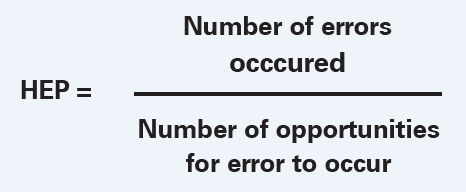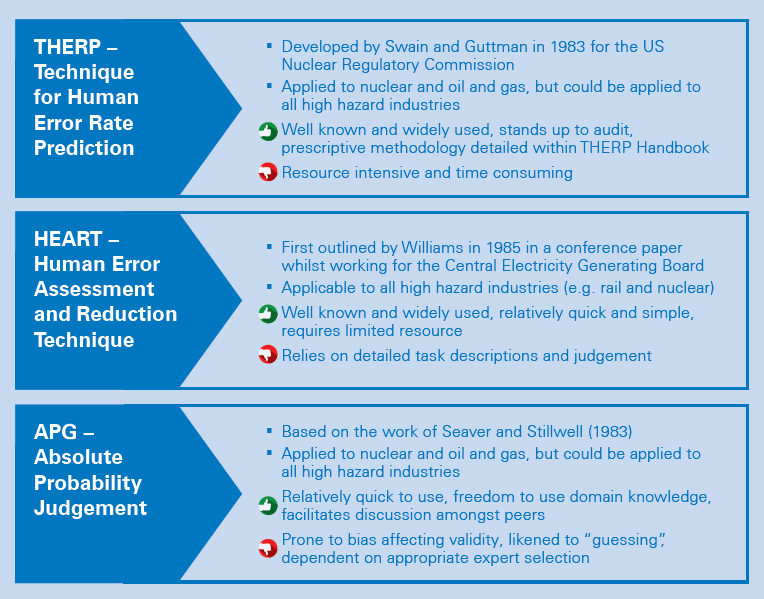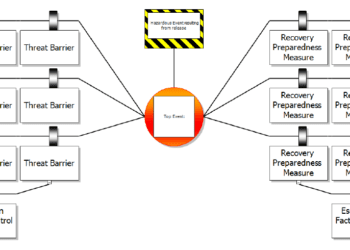Introduction to Human Reliability Assessment
Quantitative Human Reliability Assessment (HRA) can improve the safety and reliability of systems that depend on human action. It can also reduce potentially costly redesign of systems and equipment if the opportunities for human error are identified, analysed and designed out or minimised. So what is HRA, where did it come from and what are the main steps for carrying out such an assessment?

WHAT IS HUMAN RELIABILITY ASSESSMENT?
HRA involves the use of qualitative and quantitative methods to assess the human contribution to risk. There are many and varied methods available for HRA, with those first developed focused on predicting and quantifying the likelihood of human error.
The output from these methods is a Human Error Probability (HEP) of the human performance of a task or element of a task (Ref. 1). Some of the tools follow a strict methodology and step-by-step process in order to generate the HEP, while others rely solely on expert judgement.
All methods require knowledge of Human Factors and the ability to make expert judgements in relation to human error likelihood.
WHY DO HUMAN RELIABILITY ASSESSMENT?
As practitioners of these methods will know, HRA is not an exact science. However, it is a useful means of identifying and prioritising plant safety vulnerabilities to human error, and thereby reducing the frequency of associated accidents.
The assessment also identifies and informs system and equipment design features that could be implemented to minimise the likelihood of a human error actually occurring. If such opportunities for human error reduction are considered at an early design stage, the scope for potentially costly redesign can be minimised.
ORIGINS OF HUMAN RELIABILITY ASSESSMENT
Research into HRA started in the 1960s and accelerated following the Three Mile Island accident in 1979 when it became clear that human error was one of the main contributing factors (Ref. 2) that led to the partial meltdown of the reactor core.
Since then, other major accidents including the NASA Challenger disaster and Chernobyl (both in 1986) continue to highlight that human error can be a fundamental contributor to major accidents.
WHAT ARE HUMAN ERROR PROBABILITIES?
HRA techniques all quantify the Human Error Probability (HEP), which is the metric of HRA. The HEP is defined as:

There is very little HEP data available from studies and accident analysis, most likely due to the perceived sensitivity of publishing data which may imply poor performance, coupled with a lack of appreciation of why it would be useful to collect such data in the first place (Ref. 2). This is why so many of the common HRA methods rely, to a greater or lesser extent, on expert judgement.
HUMAN RELIABILITY ASSESSMENT METHODS
In 2009, the UK Health and Safety Executive (HSE) conducted a review of all known HRA methods (Ref. 3). Of the 35 human reliability tools considered, 17 were deemed to be of potential use in the major hazard sector.
A summary of three of the most well-known and widely used HRA methods is presented in Figure 1. These are:
- Technique for Human Error Rate Prediction (THERP)
- Human Error Assessment and Reduction Technique (HEART)
- Absolute Probability Judgement (APJ)

Figure 1 – Summary of three HRA Methods
STEPS FOR COMPLETING A HUMAN RELIABILITY ASSESSMENT
A common approach can be taken for all quantitative HRAs, with the overall method broken down into five high level steps.
Step 1
Task description and information gathering: Speak to the system designers, Subject Matter Experts (SME), operators, and anyone else who knows how the task in question is carried out.
Step 2
Conduct a task analysis: This is perhaps the most important step of a HRA, because it allows the analyst to break down the task into its discrete steps which then highlights where human error could occur. It also allows the analyst to identify possible recovery opportunities
Step 3
Choose the appropriate HRA methodology, and generate HEPs for the errors being assessed: Based on industry custom and practice and the types of errors being assessed, an appropriate method is chosen (e.g. HEART, THERP or APJ).
Step 4
Identify any means of human error reduction: This can be based on the Performance Shaping Factors (PSF) identified during the HRA (e.g. increased training and supervision, reduction in time pressure).
Step 5
Write up the work done, including all analysis and justification for the resulting HEPs: Being able to justify why a certain HEP is deemed appropriate and accurate is extremely important as it provides an audit trail and traceability, and is often needed to satisfy industry regulators.
QUANTITATIVE VS QUALITATIVE?
As well as quantitative HRA methods, human reliability can also be assessed using methods that don’t result in a numerical assessment of human error probability. One of the most widely used qualitative methods is Safety Critical Task Analysis (SCTA). For SCTA, the analyst systematically reviews the overall task being assessed, anticipates what failures might occur at different task steps, and analyses what factors could increase or decrease the likelihood of those failures.
This essentially follows a similar process as Steps 1 and 2 for a quantitative HRA, but with a checklist-based approach to the analysis of tasks classified as ‘high priority’. Suggested additional controls are then identified where needed and may include:
- Improvements in procedures
- Engineering modifications
- Improved access to equipment
- Provision of training or additional checks
Importantly, there isn’t a one size fits all approach for human reliability, and the type and depth of the study can be tailored to the application, ranging from high level to detailed and from qualitative to quantitative.
CONCLUSION
Although human error is often identified as a contributing cause to major accidents, there is scant data from operating experience to allow direct evaluation of HEPs. Instead, mature HRA techniques can be used, which can be applied in all high hazard industries including rail, nuclear and oil and gas.
HEPs generated from HRA feed into the safety case (e.g. QRA) and help identify areas in system and equipment design
where human failures are most significant and improvements can be made.
More information on SCTA can be found in Issue 35 of RISKworld (Spring 2019) at https://risktec.tuv.com/knowledge-bank-riskworld-newsletter/
This article first appeared in RISKworld 42, issued November 2022.
References
1. Sanders, M & McCormick, E (1992) Human Factors in Engineering and Design, McGraw-Hill Education, 7th Edition.
2. Kirwan, B (1995) Human Reliability Assessment.
3. Bell, J & Holroyd, J (2009) HSE RR679 Review of human reliability assessment methods.








